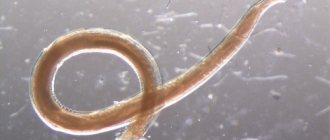7015Pavel
Nematodes (worms) are roundworms that infect the gastrointestinal tract (gastrointestinal tract). Nematodes in cats are a common occurrence that requires proper treatment. Not only yard cats and those walking on the street are at risk, but also pets. For many owners, the appearance of nematodes in a domestic cat causes surprise and confusion as to how the pet could become infected. Let's take a closer look at the causes of nematodes and how to combat them.
Nematodes are one of the types of worms. They are small, small-sized worms that enter the gastrointestinal tract and parasitize there. They spread very quickly, mainly in the small intestine, but sometimes they can be diagnosed in nearby, interconnected organs: liver, colon, esophagus. Nematodes, or roundworms, are one of the most common and frequently encountered types of helminths in cats. In addition to roundworms, cats can become infected with tapeworms and flatworms.
© shutterstock
Roundworms (nematodes) - types and methods of parasitism
Inexperienced owners are often confused by the double terminology used in parasitology. Let us immediately determine that roundworms and nematodes are the same parasites. Roundworms have a relatively simple reproduction cycle and are considered the most common on the planet. Apart from pets, roundworms affect almost all mammals, including humans.
The good news is that almost all roundworm-related illnesses are relatively easy to treat. Caution must be exercised if alarming symptoms appear in a kitten, young, weakened, lactating or pregnant cat. In these cases, therapy is carried out only under the supervision of a veterinarian.
Ascariasis or toxocariasis in cats
Due to the similarity of life cycles, method of reproduction and parasitism, four different parasites (Ascarids, Toxascaris leonina, Toxocara cati, Toxocara canis) are usually combined under one term - ascariasis. An infected animal becomes a carrier of parasite eggs. The eggs inseminate the ground, plants, water and continue on their way to the next carrier with a carrier: rodent, bird, beetles, earthworms, and so on.
Toxascaris leonina is considered the most numerous species because their life cycle is extremely simple.
A cat becomes infected by ingesting an egg, which molts in the intestines and develops into a larva. Within a few days, the larva becomes an adult, which begins to reproduce eggs, which, in turn, leave the body with feces. Once in the ground, the eggs remain viable for 6–7 days.
Toxocara cati differs from its related species in having a more complex life cycle. Unlike other types of roundworms, these parasites can enter the cat's bloodstream and milk. Simply put, if a cat is infected with parasites, her kittens will become carriers from the first days of life. Adult cats become infected with parasites by eating their eggs or the carrier.
Note! Toxocara cati has a relative - Toxocara canis; the larvae of these parasites can penetrate not only into milk, but also pass the placental barrier.
Parasite eggs spread through the environment, water, bowls and so on. Once the egg enters the cat’s body, it enters the bloodstream and migrates to the tissues. Having transformed into a larva, the parasite can encapsulate in tissues and remain viable for years. Most often, the larvae are encapsulated in the respiratory organs, which causes irritation of the mucous membranes and coughing. The cat coughs up the larva and swallows it, after which the parasite ends up in its element - the intestines.
Another option for infecting a cat is eating a carrier of parasite larvae. Carriers can be insects and worms. When a cat eats a beetle or other insect, the larvae molt only in the intestines, which helps them overcome the acid barrier of the stomach.
Whipworms or trichuriasis in cats
It's nice to recognize four main types of whipworms that infect mammals (including humans):
- Trichocephalus vulpis.
- Trichocephalus ovis.
- Trichocephalus skrjabini.
- Trichocephalus suis.
All these parasites are similar in structure, reproduction cycle and method of parasitism. For helminths to develop, certain conditions must be met. The eggs enter the external environment with the feces of the infected carrier. Maturation lasts from 2 to 3 weeks, and it is important that the eggs are in a tolerable temperature environment.
Eggs enter a cat's body by ingesting contaminated food or water. Thanks to the protective shell, the eggs pass the acid barrier of the stomach and are localized in the large intestine. It takes 3.5 months for a whipworm to grow and become sexually mature.
Note! Whipworms can live in a cat's body for up to 6 months.
Hookworm disease in cats
Infection is caused by three types of parasites:
- Ancylostoma tubaeforme.
- Ancylostoma caninum.
- Ancylostoma braziliense.
The worms are similar to each other and have similar mechanisms of parasitism and reproduction. The adult is round in shape, pinkish in color and grows up to 2 cm in length. Worms are attached to the intestinal walls by a pair of hooks located on the sides of the mouthparts.
The parasite eggs mature within 3 weeks, after which the cat can become infected through food. Direct infection occurs after drinking water or food contaminated with parasite eggs. Kittens can become infected from their mother in utero or through milk. Worms feed on blood and directly on intestinal tissue.
Strongyloidiasis in cats
The causative agent is the roundworm Strongyloides stercoralis, which grows up to 2.2 cm in length. The parasite has a complex development cycle. Worm eggs mature in the external environment, after which they molt and turn into larvae. It has been established that the larvae can enter the host’s body through the skin, sweat glands and hair follicles. Parasites literally gnaw their way through, penetrate deep tissues, after which they penetrate the bloodstream and migrate throughout the body.
Having passed the heart and lungs, the larvae reach the pharynx with the blood stream, provoke a cough, after which the animal swallows them. After passing through the upper gastrointestinal tract, the larvae enter the small intestine. All this time, the larva goes through the process of puberty, so once in its habitat, the parasites are ready to reproduce.
It is interesting that only females survive in the intestines, since they are able to penetrate the mucous membrane. Males die immediately after fertilization of females and are excreted from the body naturally.
Note! If the animal was infected orally, that is, the eggs entered the body with food or water, the larvae penetrate the mucous membranes of the oral cavity and the bloodstream.
Uncinariasis in cats
The causative agent is the nematode Uncinaria stenocephala, reaching 11 mm in length. Parasite eggs are microscopic and indistinguishable visually. Infection occurs directly; parasites do not require intermediate hosts for development. Adult worms parasitize the small intestine. After the egg is released into the external environment, the larvae hatch within 20 hours. An animal becomes infected by consuming contaminated food or water.
Note! Uncinaria stenocephala can infect animals by penetrating intact skin.
After infection, the larvae penetrate the intestinal mucosa, where they undergo adulthood. An individual that is ready to reproduce enters the intestinal lumen and begins to reproduce eggs. When infected through the skin, the larvae enter the bloodstream, through which they enter the lungs. Having matured in the respiratory organs, the larvae are coughed up and swallowed, after which they enter the intestines. Experience shows that the disease most often affects animals under 8 weeks of age.
Ancylostomides nematodes
In this type of nematode we find Ancylostoma tubaeforme and Uncinaria stenocephala. They have hooks in their mouths that are firmly attached to the small intestine to suck blood. To do this, they release an anticoagulant. If there are many parasites, they will cause significant bleeding and black stools. Characteristic symptoms of ancylostomides:
- anemia,
- weakness,
- death if the kitten has a lot of parasites.
Their size is tiny compared to roundworms 0.5-1.5 cm, and the method of transmission is trans-mammary (by drinking breast milk), antenatal (in the uterus, the larvae pass through the placenta, the kitten will be infected, which does not happen with Toxocara cati ) and even subcutaneously when infective larvae appear on the surface.
The biological cycle is the same as for Toxocara cati, except that they cannot pass through the placenta, and the treatment is the same. Here again we find intermediate hosts: rodents, birds, worms, beetles. Eggs with infested larvae are slightly less stable in the environment than roundworms, but they are stable in high humidity, moderate temperatures.
Are roundworms transmitted from cats to humans?
Many owners are concerned that worms from cats can be transmitted to humans. Let's not lie, owners and pets have quite a lot of common parasites and an invasion can really happen. However, the owner must understand that he is more likely to infect the pet than vice versa.
People are much more likely to come into contact with surfaces infested with worm eggs. If you have the habit of eating outside, often visit public places and use public transport, your palms and outer clothing are a source of infection for your pet.
It is worth accepting as a fact that you cannot protect yourself from worms, so the only way to avoid unpleasant consequences is regular prevention.
Prevention
It is always easier and cheaper to prevent helminth infection than to treat it later. To protect your cat from nematodes, you should provide him with proper feeding and care.
In your diet, try not to feed raw meat or fish. Raw meat can be given raw only after thoroughly freezing. Avoid expired or stale foods and canned goods. Food must be fresh and of high quality. If you give your cat dry food, then buy high-quality food and always check the expiration date.
Clean your cat's litter box often. Disinfect during cleaning.
A cat that freely goes outside and interacts with stray animals has a high risk of contracting worms. In addition, do not forget, worms can also be transmitted to humans.
Periodically carry out worm prevention . Give your cat anthelmintic drugs, which are sold in every pet store. Pay attention to changes in your cat's behavior, his appetite, and periodically inspect his feces for the presence of worms. If you notice symptoms of parasites in your cat, contact your veterinarian immediately.
Parasites can live in the bodies of humans and animals. Infection with worms usually occurs through contact with a carrier of parasites, when eating foods containing worm eggs, and also when drinking raw water from open sources. Cats and dogs, even if they do not go outside, can also become carriers of parasites and pose a danger to humans. Representatives of the cat family can become infected with flukes, nematodes and cestodes. All these species can also live in humans, so it is important for pets to undergo regular helminth prevention. Today we will talk about what worms look like in cats and how you can get rid of them.
Symptoms of roundworms in cats
Symptoms of ascariasis (toxocariasis) in cats:
- Apathy, decreased activity, weakness, drowsiness.
- Increase in base body temperature.
- A sharp decrease in wool quality.
- Lack of healthy shine in the eyes.
- Copious discharge from the eyes.
- Increased salivation, retching, vomiting.
- Diarrhea, often mixed with mucus.
- Weight loss due to normal nutrition, up to exhaustion.
- Anemia.
- Blueness or pallor of the mucous membranes.
- Kittens have respiratory problems and pneumonia.
- In kittens and young cats with critical infestation, tremors and seizures occur.
Symptoms of trichuriasis in cats:
- Difficulty digesting food, weight loss.
- Perversion of appetite.
- Avitaminosis.
- Dry skin.
- Weakness, decreased activity.
- Anemia of the mucous membranes.
- Physical damage to the walls of the large intestine, leading to chronic inflammatory processes.
- Muscle tremors.
- Diarrhea with mucus and blood inclusions.
- Destruction of blood vessels in intestinal tissue, which can lead to atony and necrosis.
Symptoms of hookworm in cats:
- Apathetic state and weakness, due to vitamin deficiency.
- Anemia due to constant blood loss.
- Diarrhea with mucus and blood.
- Deterioration in the quality of wool and skin.
- Deterioration of appetite and its perversion.
Symptoms of strongyloidiasis in cats:
- General weakness, apathy, decreased activity.
- Low-grade increase in base body temperature.
- Obvious signs of intoxication: copious salivation, anemia of the mucous membranes, nausea, vomiting.
- Gastrointestinal tract disorders: diarrhea with copious amounts of mucus.
- Respiratory system disorders: bronchitis, pleurisy, pneumonia.
- Severe dry cough, shortness of breath.
- Enlarged liver, jaundice, increased blood bilirubin levels.
- Symptoms of enteritis may occur.
- Allergic reaction: severe rash, itching, urticaria.
- Pain in the peritoneum, especially upon palpation.
- A sharp decrease, perversion or lack of appetite.
Symptoms of uncinariasis in cats:
- Loss or perversion of appetite.
- Alternating diarrhea and constipation.
- Weakness, exhaustion.
- Anemia of the mucous membranes.
- Diarrhea mixed with blood (due to permanent damage to the intestines) and mucus.
Important! In the early stages, uncinariasis is asymptomatic, even in kittens.
Diagnostics
How to determine that a cat has helminthiasis and not some other disease, infectious or non-infectious, in which the same symptoms appear?
This is a very important question, because if you start treatment in an adult, and even more so in a kitten, who has picked up another infection, it can end in death. An accurate diagnosis can only be made by a veterinarian based on a stool analysis.
At the slightest suspicion that your pet has worms, collect her feces in a tightly closed jar (it should be clean and dry) and take it to the veterinarian for analysis (until this time, store it in the refrigerator). At the pharmacy you can buy a special jar for testing.
Effective drugs for treatment and prevention
Treatment of helminthic infestation is not difficult, since all adult roundworms are localized in the intestines and are excreted naturally. Prevention of helminthic diseases can be dangerous if the patient is a kitten, a pregnant or lactating cat, an animal recovering from an illness or with an unknown medical history.
Important! The use of anthelmintic drugs should only be carried out under the supervision of a doctor if the animal has not received prevention of helminthic diseases for more than six months.
The problem is that the immediate death of a large number of parasites can cause severe intoxication and lead to intestinal blockage.
Tablets, suspensions and drops for roundworms in cats
All broad-spectrum anthelmintic drugs contain an active substance that kills or neutralizes roundworms. Before using the drug, carefully read the instructions, since some of them may cause an allergic reaction, nausea, excessive secretion of foamy saliva and other side effects. Of the common, proven antihelminthic drugs, it is worth highlighting:
- Tablets: Drontal, Dirofen, Pratel, Kanikvantel, Milbemax.
- Suspensions: Prazicide (and analogues), Febtal-combo.
- Drops: Profender, Stronghold, Inspector, Advantage.
Important! Be careful when carrying out preventive measures for kittens under 3 weeks of age! Most histogenic drugs are contraindicated in children. Even medications “for kittens” have age restrictions.
How to identify and treat?
It is possible to determine that a cat has a helminthic infestation by analyzing the animal's stool, where eggs or larvae of nematodes are found. In a general blood test, an indirect sign of the presence of parasites is eosinophilia. Nematodes can be detected by conducting an enzyme immunoassay to detect antibodies to certain types of worm antigens. Abscesses in muscle tissue, brain and liver can be detected during ultrasound examination.
It is important to ensure that your pet is adequately hydrated.
Treatment for nematodes should take place after determining the exact type of helminth and under the supervision of a veterinarian. Most often, the procedure involves the cat taking one of the anthelmintic medications. The most commonly used drugs are Pirantel, Naftamon, Ivomek, and Fenbendazole. You also need to provide the animal with proper dietary nutrition. The diet should be rich in proteins, vitamins and microelements. It is recommended to give plenty of fluids while taking medications.
It is necessary to train the cat, prohibiting it from picking up and eating food on the street, which will help prevent helminthic infestation.
What to do if your cat has nematodes?
Nematodes (worms) are roundworms that infect the gastrointestinal tract (gastrointestinal tract). Nematodes in cats are a common occurrence that requires proper treatment. Not only yard cats and those walking on the street are at risk, but also pets. For many owners, the appearance of nematodes in a domestic cat causes surprise and confusion as to how the pet could become infected. Let's take a closer look at the causes of nematodes and how to combat them.
Nematodes are one of the types of worms. They are small, small-sized worms that enter the gastrointestinal tract and parasitize there. They spread very quickly, mainly in the small intestine, but sometimes they can be diagnosed in nearby, interconnected organs: liver, colon, esophagus. Nematodes, or roundworms, are one of the most common and frequently encountered types of helminths in cats. In addition to roundworms, cats can become infected with tapeworms and flatworms.
What does a nematode look like in pets?
Have you been fighting against PARASITES for many years without success?
Head of the Institute: “You will be amazed at how easy it is to get rid of parasites just by taking it every day.
Nematodes are rightfully considered the most tenacious and most widespread animals on earth. To date, there are more than 24 thousand species of registered and described nematodes. After insects, they occupy the second place in terms of prevalence and diversity of species. They can live in soil, soil, fresh and salt water bodies. They exist as separately living individuals and as helminths.
Our readers successfully use Intoxic to get rid of parasites. Seeing how popular this product is, we decided to bring it to your attention. Read more here...
What is nematodosis
Nematode disease is a disease of parasitic origin caused by nematodes. Once in the human or animal body, nematodes develop and parasitize in almost all tissues and organs. The most common location is the intestine.
Nematodes that can be found in cats and dogs include:
- roundworms;
- pinworms;
- whipworms;
- toxocara;
- hookworms;
- trichinella;
- strongoloidosis.
Among the many nematodes, those listed are most often found in the body of animals, and can be transmitted from cats and dogs to humans; an example of infection can be seen in the photo.
The conditions for the development and vital activity of parasites are:
- environmental climatic conditions;
- presence of necessary intermediate hosts;
- living conditions for animals;
- sanitary and hygienic conditions for keeping and living animals.
In the presence of all the necessary factors for life and reproduction, coupled with the lack of basic hygiene standards, animals are exposed to nematode infection, putting people at risk.
The health of cats and dogs, which most often are full members of the family, must be carefully monitored, since they pose a direct threat to their owners.
How do nematodes manifest themselves in animals?
When nematodes enter the body of cats and dogs, they cause disruption of the digestive tract. By destroying the epithelial layer of the intestine, they can cause abdominal pain. Animals have a reduced pain barrier compared to humans, so in them helminthiasis manifests itself in the form of stool disorders and refusal to eat.
In addition to affecting the digestive system, nematodes affect the functioning of the central nervous system. By releasing toxic substances during their life processes, nematodes poison the central nervous system. This symptom manifests itself as apathy, general weakness, loss of strength. In cats, this symptom is less noticeable, since cats themselves are calm and apathetic creatures. In dogs, this manifestation of the disease is more noticeable, see photo.
After a certain time required for the nematodes to mature and reproduce, confirmation of the disease can be detected in the animal’s feces. This period depends on the type of parasite.
Pets living under the same roof as their owner must regularly undergo anthelmintic therapy. If the animal does become ill and the degree of progress of the disease is great, it is recommended that all family members undergo an anti-parasitic program and accompanying treatment, after first finding out what type of parasite has settled in the house.
How to treat nematodosis?
Treatment of nematodes consists of two main blocks:
Deworming is carried out with the aim of destroying parasites living in the host’s body, in this case it is the body of cats and dogs. Prophylaxis is a preventive measure to prevent re-infection and the need for treatment.
Deworming should be carried out after the type of parasite has been determined. Fecal tests to detect worms are carried out in laboratories based in veterinary clinics. Some private human laboratories also conduct animal feces tests for a fee.
We recommend reading: Can Feline Distemper Be Treated With Vodka?
Once the type of parasite has been determined, treatment can begin. For deworming of animals, drugs in tablet form are used:
In rare cases, animals immediately swallow the tablet. Most often they spit it out, refusing to swallow it. Some drug manufacturers recommend taking the tablets in such a way that the outer shell remains intact, that is, it enters the intestines undigested. This is the main difficulty for owners of cats and dogs: getting the animal to stroke the medicine.
In order for your pet to swallow the tablet, it is placed in his mouth with his head thrown back and his neck is stroked with smooth movements. These movements are stimulators of unconditional swallowing.
In addition to antiparasitic drugs, there are drops that paralyze worms. Drops are applied to the withers, from where the active substances enter the vascular tissue of the intestine through the bloodstream. Only nematodes are sensitive to paralytics. After paralysis occurs, the worms leave the host's body.
The prevention needed to prevent reinfection in cats and dogs is also important for people. Preventive measures include repeated deworming after a certain period of time. Depending on their species, nematodes have different development cycle lengths. Repeated deworming is aimed at destroying young worms that have matured from eggs laid by dead worms.
In addition to repeated deworming, the hygiene of the animal itself is important. Following basic recommendations for food preparation, periodic disinfection of the pet’s home and area.
The cleanliness of the cats and dogs with whom we come into contact is the key to our health, so it is important to monitor what the animal eats and with whom it comes into contact, since treatment of helminthiasis is a long and unpleasant process.
Author of the article: Alexandra O.
It's worth reading
In the presence of all the necessary factors for life and reproduction, coupled with the lack of basic hygiene standards, animals are exposed to nematode infection, putting people at risk.
Treatment
Treatment of a cat suffering from infectious anemia begins only after confirmation of the diagnosis in a veterinary clinic (the diagnosis takes into account the symptoms and hemobartonella detected during a laboratory blood test).
The veterinarian prescribes tetracycline antibiotics twice a day for a long time (until there are no pathogens left in the blood). Levomycetin is also used twice - three times a day. Be sure to prescribe medications that stimulate the production of blood cells and help restore the hematopoietic organs. The administration of synthetic glucocorticoids gives good results.
But remember that the treatment regimen, as well as the dosage, frequency of drug administration and duration of the course of therapy are selected and prescribed only by a veterinarian! Self-medication is extremely dangerous!
How can you tell if your pet is infected with helminths?
There are many causative agents of helminthiases, so the symptoms of the disease vary. They also depend on the number of parasites, the type of organ inhabited by them, and the state of health of the animal. You can tell that your pet has worms by looking at some symptoms common to helminthiasis: the appearance of eggs or worms in the feces, changes in the cat’s behavior.
Obvious signs: worms in stool or vomit
The vast majority of parasitic worms live in the digestive tract. Having detached from the walls of the affected organ, they come out with feces under the influence of peristalsis. When removing the tray of an infected animal, you may notice small worms or white eggs in the excrement - this is the main sign of the disease. Sometimes worms are found in the anus. If a pet with an extensive helminthic infestation vomits, the parasites can be seen in the vomit, but in it they look a little different - like long transparent threads.
Changes in behavior and well-being
While in the digestive tract, parasites deprive the cat of a significant part of its nutrients, so the animal becomes lethargic. The pet feels very weak and gets tired quickly. He sleeps a lot, prefers to spend the rest of the time lying down, even if before that he was a lover of outdoor games. The cat’s attitude towards food changes - it can either refuse food or suffer from a “brutal” appetite. Vomiting often occurs after feeding.
You can also find out about the presence of helminths by the following signs:
- weight loss regardless of the amount of food consumed;
- digestive disorders – diarrhea, constipation (may alternate);
- bloated belly;
- cough;
- increased lacrimation, white thick discharge from the eyes;
- deterioration in the appearance of the coat;
- itching in the anus area.
Parasites in cats can cause coughing when it comes to lungworms, most commonly Capillaria aerophila, Aelurostrongylus abstrusus and Paragonimus kellicotti. Worm cough occurs when parasites enter the bloodstream through the intestinal wall and reach the lungs. Lungworms in cats cause not only coughing, but also shortness of breath, and sometimes fever. When helminthiasis passes into the chronic stage due to scarring of organ tissue, a cough can torment the animal for life.











